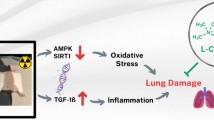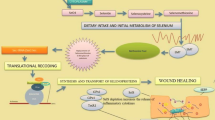Abstract
Selenocystine (CysSeSeCys), a diselenide aminoacid exhibiting glutathione peroxidase-like activity and selective antitumor effects, was examined for in vivo antigenotoxic and antioxidant activity in Swiss albino mice after exposure to a sublethal dose (5 Gy) of γ-radiation. For this, CysSeSeCys was administered intraperitoneally (i.p.) to mice at a dosage of 0.5 mg/kg body weight for 5 consecutive days prior to whole-body γ-irradiation. When examined in the hepatic tissue, CysSeSeCys administration reduced the DNA damage at 30 min after radiation exposure by increasing the rate of DNA repair. Since antigenotoxic agents could alter the expression of genes involved in cell cycle arrest and DNA repair, the transcriptional changes in p53, p21 and GADD45α were monitored in the hepatic tissue by real-time PCR. The results show that CysSeSeCys alone causes moderate induction of these three genes. However, CysSeSeCys pretreatment resulted in a suppression of radiation-induced enhancement of p21 and GADD45α expression, but did not affect p53 expression. Further analysis of radiation-induced oxidative stress markers in the same tissue indicated that CysSeSeCys significantly inhibits lipid peroxidation and prevents the depletion of antioxidant enzymes and glutathione (GSH) levels. Additionally, it also prevents radiation-induced DNA damage in other radiation sensitive cellular systems like peripheral leukocytes and bone marrow, which was evident by a decrease in comet parameters and micronucleated polychromatic erythrocytes (mn-PCEs) frequency, respectively. Based on these observations, it is concluded that CysSeSeCys exhibits antigenotoxic effects, reduces radiation-induced oxidative stress, and is a promising candidate for future exploration as a radioprotector.





Similar content being viewed by others
References
Aboul-Fadl T (2005) Selenium derivatives as cancer preventive agents. Curr Med Chem Anticancer Agents 5:637–652
Amanullah A, Azam N, Balliet A, Hollander C, Hoffman B, Fornace A, Liebermann D (2003) Cell signalling: cell survival and a Gadd45-factor deficiency. Nature 424:741–742
Aykin-Burns N, Ercal N (2006) Effects of selenocystine on lead-exposed Chinese hamster ovary (CHO) and PC-12 cells. Toxicol Appl Pharmacol 214:136–143
Bhilwade HN, Chaubey RC, Chauhan PS (2004) Gamma ray induced bone marrow micronucleated erythrocytes in seven strains of mouse. Mutat Res 560:19–26
Brozmanova J, Manikova D, VIckova V, Chovanec M (2010) Selenium: a double-edged sword for defense and offence in cancer. Arch Toxicol. doi 10.1007/s00204-010-0595-8
Chen T, Wong Y-S (2008) Selenocystine induces S-Phase arrest and apoptosis in human breast adenocarcinoma MCF-7 cells by modulating ERK and Akt phosphorylation. J Agric Food Chem 56:10574–10581
Chen T, Wong Y-S (2009a) Selenocystine induces reactive oxygen species-mediated apoptosis in human cancer cells. Biomed Pharmacother 63:105–113
Chen T, Wong Y-S (2009b) Selenocystine induces caspase-indepandant apoptosis in MCF-7 human breast carcinoma cells with involvement of p53 phosphorylation and reactive oxygen species generation. Int J Biochem Cell Biol 41:666–676
Clark LC, Combs GF Jr, Turnbull BW, Slate EH, Chalker DK, Chow J, Davis LS, Glover RA, Graham GF, Gross EG, Krongrad A, Lesher JL Jr, Park HK, Sanders BB Jr, Smith CL, Taylor JR (1996) Effects of selenium supplementation for cancer prevention in patients with carcinoma of the skin: a randomized controlled trial. JAMA 276:1957–1963
Coates PJ, Lorimore SA, Wright EG (2004) Damaging and protective cell signaling in the untargeted effects of ionizing radiation. Mutat Res 568:5–20
Devipriya N, Sudheer AR, Srinivasan M, Menon VP (2008) Quercetin ameliorates gamma radiation-induced DNA damage and biochemical changes in human peripheral blood lymphocytes. Mutat Res 654:1–7
Diamond AM, Dale P, Murray JL, Gardina DJ (1996) The inhibition of radiation induced mutagenesis by the combined effects of selenium and the aminothiol WR-1065. Mutat Res 356:147–154
Drake EN (2006) Cancer chemoprevention: selenium as a prooxidant, not an antioxidant. Med Hypothesis 67:318–322
Ejadi S, Bhattacharya ID, Voss K, Singletary K, Milner JA (1989) In vitro and in vivo effects of sodium selenite on 7.12-dimethylbenz[a]anthracene-DNA adduct formation in isolated rat mammary epithelial cells. Carcinogenesis 10:823–826
El-Bayoumy K (2001) The protective role of selenium on genetic damage and on cancer. Mutat Res 475:123–139
El-Bayoumy K, Sinha R (2004) Mechanisms of mammary cancer chemoprevention by organoselenium compounds. Mutat Res 551:181–197
El-Bayoumy K, Sinha R (2005) Molecular chemoprevention by selenium: a genomic approach. Mutat Res 591:224–236
Fico MR, Poirer KA, Watrach AM, Watrach MA, Milner JA (1986) Differential effects of selenium on normal and neoplastic canine mammary cells. Cancer Res 46:3384–3388
Glasgow GP (1982) The dosimetry of fixed, single source hemibody and total body irradiators. Med Phys 9:311–323
Goel A, Fuerst F, Hotchkiss E, Boland CR (2006) Selenomethionine induces p53 mediated cell cycle arrest and apoptosis in human colon cancer cells. Cancer Biol Ther 5:529–535
Ha SE, Shin DH, Kim HD, Shim SM, Kim HS, Kim BH, Lee JS, Park JK (2010) Effects of ginsenoside Rg2 on the ultraviolet B-induced DNA damage responses in HaCaT cells. Naunyn Schmiedebergs Arch Pharmacol 382:89–101
Han Y, Son S-J, Akhalaia M, Platonov A, Son H-J, Lee K-H, Yun Y-S, Song J-Y (2005) Modulation of radiation induced disturbances of antioxidant defense systems by ginsan. eCAM 2:529–536
Hissin PJ, Hilf R (1976) A fluorometric method for determination of oxidized and reduced glutathione in tissues. Anal Biochem 74:214–226
Jagetia GC, Reddy TK (2002) The grapefruit flavanone naringin protects against the radiation-induced genomic instability in the mice bone marrow: a micronucleus study. Mutat Res 519:37–44
Koenig S, Krause P, Schmidt T-K, Rave-Fraenk M, Rothe H, Hermann RM, Becker H, Hess CF, Christiansen H (2008) Irradiation as preparative regimen for hepatocyte transplantation causes prolonged cell cycle block. Int J Radiat Biol 84:285–298
Kunwar A, Narang H, Priyadarsini KI, Krishna M, Pandey R, Sainis KB (2007) Delayed activation of PKCδ and NFκB and higher radioprotection in splenic lymphocytes by copper (II)-curcumin (1:1) complex as compared to curcumin. J Cell Biochem 102:1214–1224
Kunwar A, Bansal P, Kumar SJ, Bag PP, Paul P, Reddy ND, Kumbhare LB, Jain VK, Chaubay RC, Unnikrishnan MK, Priyadarsini KI (2010) In vivo radioprotection studies of 3,3′-diselenodipropionic acid, a selenocystine derivative. Free Radic Biol Med 48:399–410
Maclachlan T, Narayanan B, Gerlach VL, Smithson G, Gerwien RW, Folkerts OE, Fey G, Watkins B, Seed T, Alvarez E (2005) Human fibroblast growth factor 20 (FGF-20; CG53135–05): a novel cytoprotectant with radioprotective potential. Int J Radiat Biol 81:567–579
Mansour HH, Hafez HF, Fahmy NM, Hanafi N (2008) Protective effect of N-acetylcysteine against radiation induced DNA damage and hepatic toxicity in rats. Biochem Pharmacol 75:773–780
Mishra B, Kumbhare LB, Jain VK, Priyadarsini KI (2008) Pulse Radiolysis studies on reactions of hydroxyl radicals with selenocystine derivatives. J Phys Chem B 112:4441–4446
Nakamuro K, Okuno T, Hasegawa T (2000) Metabolism of selenoamino acids and contribution of selenium methylation to their toxicity. J Health Sci 46:418–421
Pfaffl MW, Horgan GW, Dempfle L (2002) Relative expression software tool (REST©) for group-wise comparision and statistical analysis of relative expression results in real-time PCR. Nucleic Acids Res 30:36
Pinto JT, Sinha R, Papp K, Facompre ND, Desai D, El-Bayoumy K (2007) Differential effects of naturally occurring and synthetic organoselenium compounds on biomarkers in androgen responsive and androgen independent human prostate carcinoma cells. Int J Cancer 120:1410–1417
Prabhakar KR, Veerapur VP, Bansal P, Parihar VK, Reddy KM, Kumar PB, Priyadarsini KI, Unnikrishnan MK (2007) Antioxidant and radioprotective effect of the active fraction of Pilea microphylla (L.) ethanolic extract. Chem Biol Interact 165:22–32
Ramadan LA, Roushdy HM, Abusenna GM, Amin NE, El-Deshw OA (2002) Radioprotective effect of Silymarin against radiation induced hepatotoxicity. Pharmacol Res 45:447–454
Riley PA (1994) Free radicals in biology: oxidative stress and the effects of ionizing radiation. Int J Radiat Biol 65:27–33
Rosa RM, Moura DJ, eSilva ACR, Saffi J, Henriques JAP (2007) Antioxidant activity of diphenyl diselenide prevents the genotoxicity of several mutagens in Chinese hamster V79 cells. Mutat Res 631:44–54
Rosin MP (1981) Inhibition of spontaneous mutagenesis in yeast cultures by selenite, selenate and selenide. Cancer Lett 13:7–14
Sam M, Nunoshiba T, Nishioka H, Yagi T, Takebe H (1991) Protective effects of sodium selenite on killing and mutation by N-methyl-N′-nitro-nitrosoguanidine in E. coli. Mutat Res 250:73–77
Santhosh Kumar B, Kunwar A, Ahmad A, Kumbhare LB, Jain VK, Priyadarsini KI (2009) In vitro radioprotection studies of organoselenium compounds: differences between mono and diselenides. Radiat Environ Biophys 48:379–384
Santhosh Kumar B, Kunwar A, Singh B, Ahmad A, Priyadarsini KI (2010) Anti-hemolytic and peroxyl radical scavenging ability of organoselenium compounds. Biol Trace Elem Res. doi 10.1007/s12011-010-8692-3
Schrauzer GN (2000) Anticarcinogenic effects of selenium. Cell Mol Life Sci 57:1864–1873
Seo YR, Kelley MR, Smith ML (2002) Selenomethionine regulation of p53 by a ref1-dependent redox mechanism. Proc Natl Acad Sci USA 99:14548–14553
Shilo S, Pardo M, Aharoni-Simon M, Glibter S, Tirosh O (2008) Selenium supplementation increases liver MnSOD expression: molecular mechanism for hepato-protection. J Inorg Biochem 102:110–118
Singh M, Kaur P, Sandhir R, Kiran R (2008) Protective effects of vitamine E against atrazine-induced genotoxicity in rats. Mutat Res 654:145–149
Smith ML, Kontny HU, Zhan Q, Sreenath A, O’Connor PM, Fornace AJ Jr (1996) Antisense GADD45 expression results in decreased DNA repair and sensitizes cells to UV irradiation or cisplatin. Oncogene 13:2255–2263
Smith ML, Ford JM, Hollander MC, Bortnick RA, Amundson SA, Seo YR, Deng CX, Hanawalt PC, Fornace AJ Jr (2000) p53-mediated DNA repair responses to UV radiation: studies of mouse cells lacking p53, p21, and/or gadd45 genes. Mol Cell Biol 20:3705–3714
Soriano-Garcia M (2004) Organoselenium compounds as potential therapeutic and chemopreventive agents: a review. Curr Med Chem 11:1657–1669
Tapiero H, Townsen DM, Tew KD (2003) The antioxidant role of selenium and selenol-compounds. Biomed Pharmacother 57:134–144
Xiong Y, Hannon GJ, Zhang H, Casso D, Kobayashi R, Beach D (1993) p21 is a universal inhibitor of cyclin kinases. Nature 366:701–714
Zhang Y, Rohde LH, Emami K, Hammond D, Casey R, Mehta SK, Jeevarajan A, Pierson DL, Wu H (2008) Suppressed expression of non DSB repair genes inhibits gamma radiation induced cytogenetic repair and cell cycle arrest. DNA Repair 7:1835–1845
Acknowledgments
The authors are thankful to Drs. K. B. Sainis, T. Mukherjee, and S. K. Sarkar, for their encouragement and support to this work. HB thanks Indian Academy of Sciences for a summer research fellowship (2008).
Author information
Authors and Affiliations
Corresponding author
Rights and permissions
About this article
Cite this article
Kunwar, A., Jayakumar, S., Bhilwade, H.N. et al. Protective effects of selenocystine against γ-radiation-induced genotoxicity in Swiss albino mice. Radiat Environ Biophys 50, 271–280 (2011). https://doi.org/10.1007/s00411-011-0352-2
Received:
Accepted:
Published:
Issue Date:
DOI: https://doi.org/10.1007/s00411-011-0352-2




